San Mateo Public Works Department
The City of San Mateo citizens service academy spent an evening at City
Hall as the guests of the Public Works Department. These are some of my
notes and pictures...
Glenn Tenney
You look at the schedule and see that an evening is going to be with the
Public Works Department and think "How interesting can THAT be?".
The department deals with fixing pot-holes in the street, street sweeping,
sewer lines, and sewage treatment. Well, they anticipated we might have
that expectation so they found a solution...
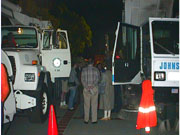 They took over the outdoor parking lot at City Hall that evening bringing
in a half dozen or so of their equipment trucks. Since our meeting started
at 6:30 p.m., they also brought generators and street work lights. This
first picture shows a sewer cleaner truck on the left (it has a long arm
on the top that can plug in to a sewer line and "suck it out"),
and a street sweeper on the right.
They took over the outdoor parking lot at City Hall that evening bringing
in a half dozen or so of their equipment trucks. Since our meeting started
at 6:30 p.m., they also brought generators and street work lights. This
first picture shows a sewer cleaner truck on the left (it has a long arm
on the top that can plug in to a sewer line and "suck it out"),
and a street sweeper on the right.
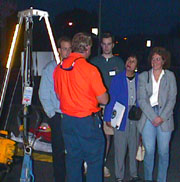 They no longer pull up a manhole cover and climb down into sewers. Now
they oxygen masks, special suits, and this tight-space machine to lower
people down into the sewers --- or any other hole in the ground or in other
tight spaces. This crew also has a remote TV camera at the end of a few
hundred foot long sewer snake.
They no longer pull up a manhole cover and climb down into sewers. Now
they oxygen masks, special suits, and this tight-space machine to lower
people down into the sewers --- or any other hole in the ground or in other
tight spaces. This crew also has a remote TV camera at the end of a few
hundred foot long sewer snake.
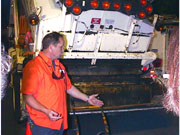 The City has their own crews and equipment to do "spot" repairs
of road surfaces. This is an asphalt truck they use to fix pot holes up
to about a dozen or so square feet. Beyond that, they contract out for
large repairs.
The City has their own crews and equipment to do "spot" repairs
of road surfaces. This is an asphalt truck they use to fix pot holes up
to about a dozen or so square feet. Beyond that, they contract out for
large repairs.
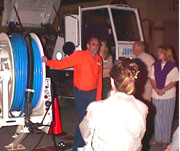 Since the City has 260 miles of sewer line, they need to do a lot of ongoing
maintenance and repairs. Sewer lines are continuously getting plugged and
coated on the inside with goop / sludge / grease / etc., so they need to
rooter them out and suck out that goop. The truck shown in the first picture
on this page also has a rooter machine that can go down into the sewers
and scrape them out.
Since the City has 260 miles of sewer line, they need to do a lot of ongoing
maintenance and repairs. Sewer lines are continuously getting plugged and
coated on the inside with goop / sludge / grease / etc., so they need to
rooter them out and suck out that goop. The truck shown in the first picture
on this page also has a rooter machine that can go down into the sewers
and scrape them out.
I'll admit it, it was actually much more interesting than I had expected.
The crews we spoke with were glad to answer our questions. Considering
that they put in long hard days, we were quite thankful that they put in
the extra time to talk with us. I was curious how much it cost the City
to have the crews set up the equipment and talk with us about their jobs...
The estimate I was given was on the order of $200-300 or so for the hour
and a half it took.
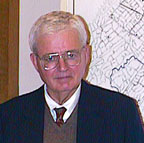 Arch Perry is the director of the Public Works department. He's a
long-time member of this department. His talk focused on the water treatment
plant -- what we regular folks would call a sewage treatment plant. On
a normal dry-weather day there's 12-15 million gallons of sewage coming
into the plant to be treated before it can be dumped into the San Francisco
Bay. On a rainy day that number goes up to 40 million gallons! Since we
have a separate system (ie. the storm drains do NOT send water into the
treatment plant), we wondered why there was such a difference. The explanation:
All of the cracks, joints, and broken sewer pipes have that much drainage
into the system.
Arch Perry is the director of the Public Works department. He's a
long-time member of this department. His talk focused on the water treatment
plant -- what we regular folks would call a sewage treatment plant. On
a normal dry-weather day there's 12-15 million gallons of sewage coming
into the plant to be treated before it can be dumped into the San Francisco
Bay. On a rainy day that number goes up to 40 million gallons! Since we
have a separate system (ie. the storm drains do NOT send water into the
treatment plant), we wondered why there was such a difference. The explanation:
All of the cracks, joints, and broken sewer pipes have that much drainage
into the system.
The treatment plant has a 54 inch outflow pipe at the mid-span of the San
Mateo Bridge. The 40 tons of solids coming in ends up as a truckload of
ash since we're one of the two Bay Area cities which burn our solid
waste (Palo Alto is the other city). It takes about a day to process incoming
waste. Our plant services parts of a few neighboring cities as well as
all of Foster City -- which owns a 27% share of our plant.
Below are a couple of Arch Perry's staff members who spoke at our "class".
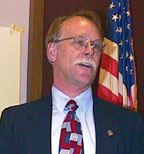 Vernon Ficklin is the maintenance manager for the department. Vern had
quite a few interesting tidbits of statistics. The city has 260 miles of
sewers, 24 pump stations, the staff goes out on 2900 sewer related calls
a year, they do 136 spot repairs to the sewer lines each year, we have 80
miles of storm water lines (Note: San Mateo has a separate system so
that anything going down a storm drain goes untreated into the San
Francisco Bay!), we have 16 miles of creeks etc., there are 5000 catch
basins (some just transfer water from one side of the street to the other
side), we have our own lagoon (the Marina Lagoon) which offers water skiing
for a fee (they estimate that it costs the City $50,000 a year extra for
extra treatment and work to support those stink pots on the lagoon), they
fix about 700 pot-holes a year, there are about 60 traffic signals maintained
by the City (the rest are under the control of Cal Trans), they paint 22
miles of curbs a year, and they sweep 18,000 curb miles of the street each
year.
Vernon Ficklin is the maintenance manager for the department. Vern had
quite a few interesting tidbits of statistics. The city has 260 miles of
sewers, 24 pump stations, the staff goes out on 2900 sewer related calls
a year, they do 136 spot repairs to the sewer lines each year, we have 80
miles of storm water lines (Note: San Mateo has a separate system so
that anything going down a storm drain goes untreated into the San
Francisco Bay!), we have 16 miles of creeks etc., there are 5000 catch
basins (some just transfer water from one side of the street to the other
side), we have our own lagoon (the Marina Lagoon) which offers water skiing
for a fee (they estimate that it costs the City $50,000 a year extra for
extra treatment and work to support those stink pots on the lagoon), they
fix about 700 pot-holes a year, there are about 60 traffic signals maintained
by the City (the rest are under the control of Cal Trans), they paint 22
miles of curbs a year, and they sweep 18,000 curb miles of the street each
year.
 Liz Diamond is the City Engineer. She showed us one of the video tapes
made of a sewer line that needed repair. It was amazing to see some of
the old clay pipes cracked and falling in -- knowing that the untreated
sewage was just seeping into that person's back yard. We then went
on a short "tour" of their offices and had a chance to meet with
the City Surveyor who showed how they're converting all of the city's
maps to AutoDesk.
Liz Diamond is the City Engineer. She showed us one of the video tapes
made of a sewer line that needed repair. It was amazing to see some of
the old clay pipes cracked and falling in -- knowing that the untreated
sewage was just seeping into that person's back yard. We then went
on a short "tour" of their offices and had a chance to meet with
the City Surveyor who showed how they're converting all of the city's
maps to AutoDesk.
Vern Bessey (the environmental compliance coordinator) also spoke with us.
(Sorry, Vern, but no picture... ) Basically, city businesses and residents
need to understand that everything going down the drain needs to be treated
-- and some things make it much more difficult for the City; and that the
storm drains send untreated water out to the Bay.
Go back to the Citizens' Service Academy page
Go back to our San Mateo page
Go back to gtenney.com's page
This site Copyright © 1997 Fantasia Systems Inc.
 They took over the outdoor parking lot at City Hall that evening bringing
in a half dozen or so of their equipment trucks. Since our meeting started
at 6:30 p.m., they also brought generators and street work lights. This
first picture shows a sewer cleaner truck on the left (it has a long arm
on the top that can plug in to a sewer line and "suck it out"),
and a street sweeper on the right.
They took over the outdoor parking lot at City Hall that evening bringing
in a half dozen or so of their equipment trucks. Since our meeting started
at 6:30 p.m., they also brought generators and street work lights. This
first picture shows a sewer cleaner truck on the left (it has a long arm
on the top that can plug in to a sewer line and "suck it out"),
and a street sweeper on the right. They no longer pull up a manhole cover and climb down into sewers. Now
they oxygen masks, special suits, and this tight-space machine to lower
people down into the sewers --- or any other hole in the ground or in other
tight spaces. This crew also has a remote TV camera at the end of a few
hundred foot long sewer snake.
They no longer pull up a manhole cover and climb down into sewers. Now
they oxygen masks, special suits, and this tight-space machine to lower
people down into the sewers --- or any other hole in the ground or in other
tight spaces. This crew also has a remote TV camera at the end of a few
hundred foot long sewer snake. The City has their own crews and equipment to do "spot" repairs
of road surfaces. This is an asphalt truck they use to fix pot holes up
to about a dozen or so square feet. Beyond that, they contract out for
large repairs.
The City has their own crews and equipment to do "spot" repairs
of road surfaces. This is an asphalt truck they use to fix pot holes up
to about a dozen or so square feet. Beyond that, they contract out for
large repairs. Since the City has 260 miles of sewer line, they need to do a lot of ongoing
maintenance and repairs. Sewer lines are continuously getting plugged and
coated on the inside with goop / sludge / grease / etc., so they need to
rooter them out and suck out that goop. The truck shown in the first picture
on this page also has a rooter machine that can go down into the sewers
and scrape them out.
Since the City has 260 miles of sewer line, they need to do a lot of ongoing
maintenance and repairs. Sewer lines are continuously getting plugged and
coated on the inside with goop / sludge / grease / etc., so they need to
rooter them out and suck out that goop. The truck shown in the first picture
on this page also has a rooter machine that can go down into the sewers
and scrape them out. Arch Perry is the director of the Public Works department. He's a
long-time member of this department. His talk focused on the water treatment
plant -- what we regular folks would call a sewage treatment plant. On
a normal dry-weather day there's 12-15 million gallons of sewage coming
into the plant to be treated before it can be dumped into the San Francisco
Bay. On a rainy day that number goes up to 40 million gallons! Since we
have a separate system (ie. the storm drains do NOT send water into the
treatment plant), we wondered why there was such a difference. The explanation:
All of the cracks, joints, and broken sewer pipes have that much drainage
into the system.
Arch Perry is the director of the Public Works department. He's a
long-time member of this department. His talk focused on the water treatment
plant -- what we regular folks would call a sewage treatment plant. On
a normal dry-weather day there's 12-15 million gallons of sewage coming
into the plant to be treated before it can be dumped into the San Francisco
Bay. On a rainy day that number goes up to 40 million gallons! Since we
have a separate system (ie. the storm drains do NOT send water into the
treatment plant), we wondered why there was such a difference. The explanation:
All of the cracks, joints, and broken sewer pipes have that much drainage
into the system.  Vernon Ficklin is the maintenance manager for the department. Vern had
quite a few interesting tidbits of statistics. The city has 260 miles of
sewers, 24 pump stations, the staff goes out on 2900 sewer related calls
a year, they do 136 spot repairs to the sewer lines each year, we have 80
miles of storm water lines (Note: San Mateo has a separate system so
that anything going down a storm drain goes untreated into the San
Francisco Bay!), we have 16 miles of creeks etc., there are 5000 catch
basins (some just transfer water from one side of the street to the other
side), we have our own lagoon (the Marina Lagoon) which offers water skiing
for a fee (they estimate that it costs the City $50,000 a year extra for
extra treatment and work to support those stink pots on the lagoon), they
fix about 700 pot-holes a year, there are about 60 traffic signals maintained
by the City (the rest are under the control of Cal Trans), they paint 22
miles of curbs a year, and they sweep 18,000 curb miles of the street each
year.
Vernon Ficklin is the maintenance manager for the department. Vern had
quite a few interesting tidbits of statistics. The city has 260 miles of
sewers, 24 pump stations, the staff goes out on 2900 sewer related calls
a year, they do 136 spot repairs to the sewer lines each year, we have 80
miles of storm water lines (Note: San Mateo has a separate system so
that anything going down a storm drain goes untreated into the San
Francisco Bay!), we have 16 miles of creeks etc., there are 5000 catch
basins (some just transfer water from one side of the street to the other
side), we have our own lagoon (the Marina Lagoon) which offers water skiing
for a fee (they estimate that it costs the City $50,000 a year extra for
extra treatment and work to support those stink pots on the lagoon), they
fix about 700 pot-holes a year, there are about 60 traffic signals maintained
by the City (the rest are under the control of Cal Trans), they paint 22
miles of curbs a year, and they sweep 18,000 curb miles of the street each
year. Liz Diamond is the City Engineer. She showed us one of the video tapes
made of a sewer line that needed repair. It was amazing to see some of
the old clay pipes cracked and falling in -- knowing that the untreated
sewage was just seeping into that person's back yard. We then went
on a short "tour" of their offices and had a chance to meet with
the City Surveyor who showed how they're converting all of the city's
maps to AutoDesk.
Liz Diamond is the City Engineer. She showed us one of the video tapes
made of a sewer line that needed repair. It was amazing to see some of
the old clay pipes cracked and falling in -- knowing that the untreated
sewage was just seeping into that person's back yard. We then went
on a short "tour" of their offices and had a chance to meet with
the City Surveyor who showed how they're converting all of the city's
maps to AutoDesk.